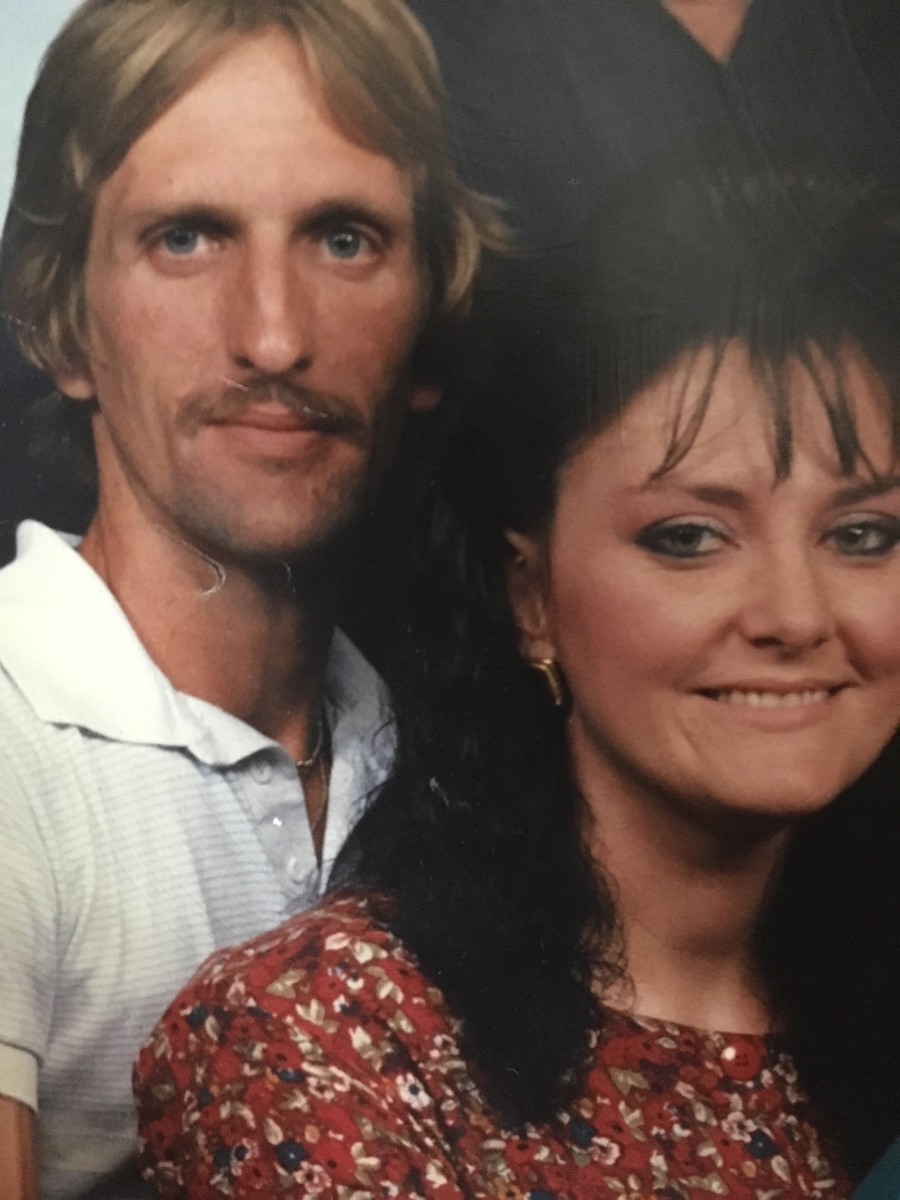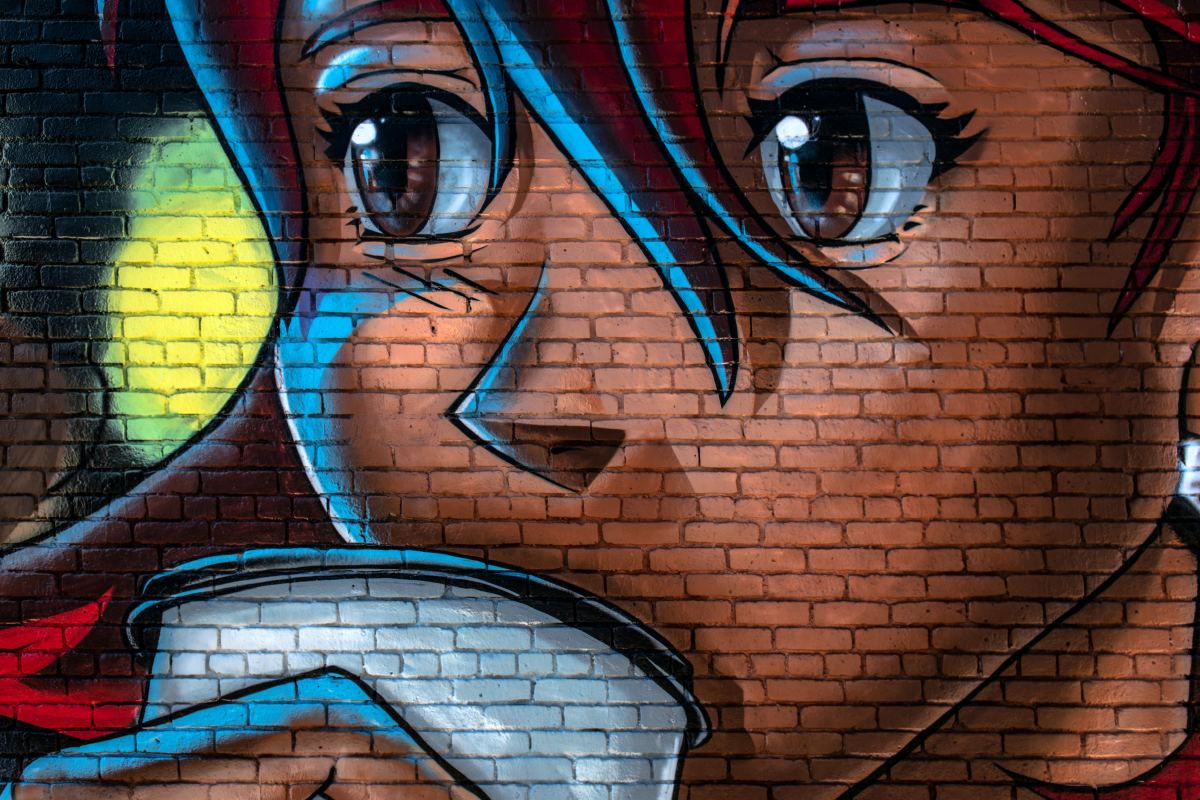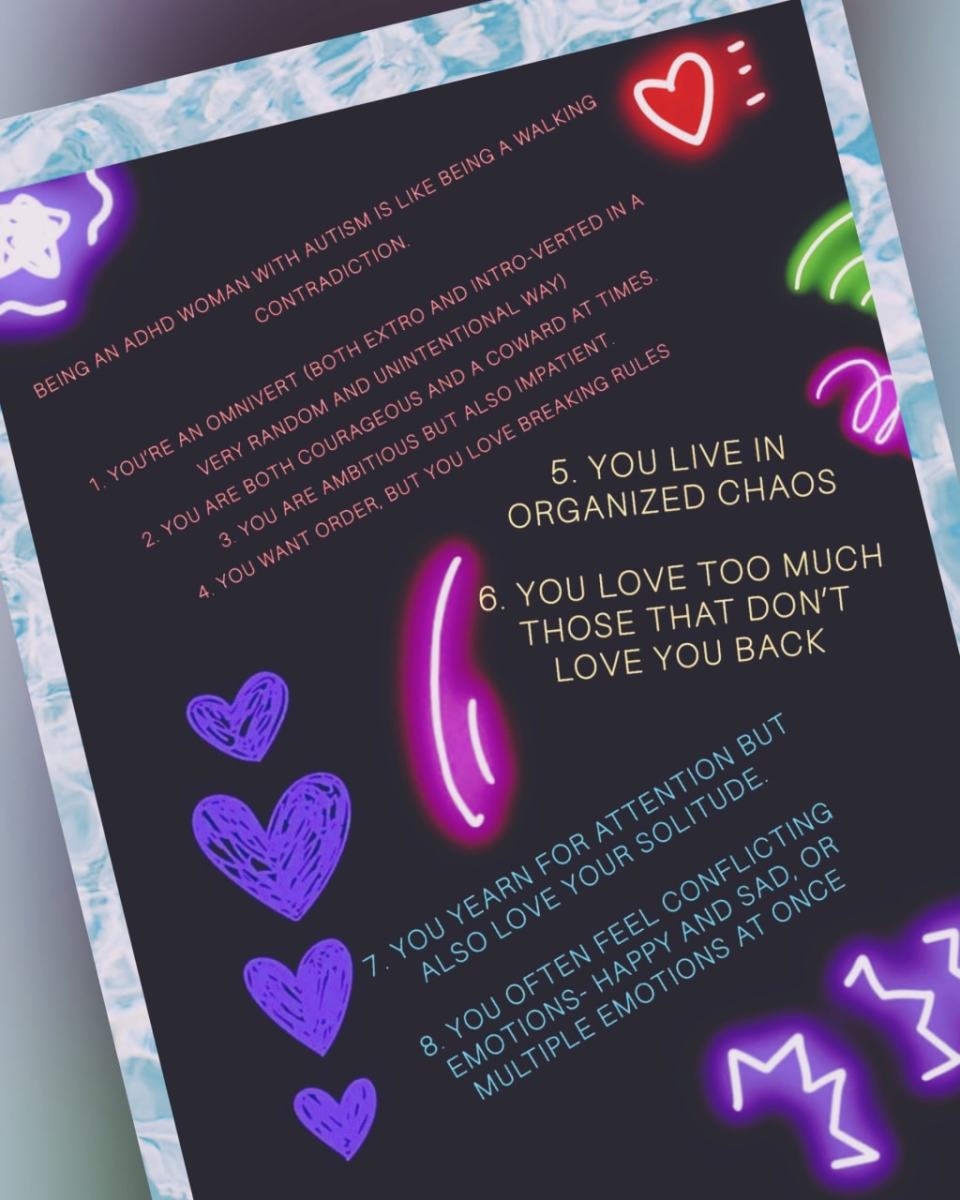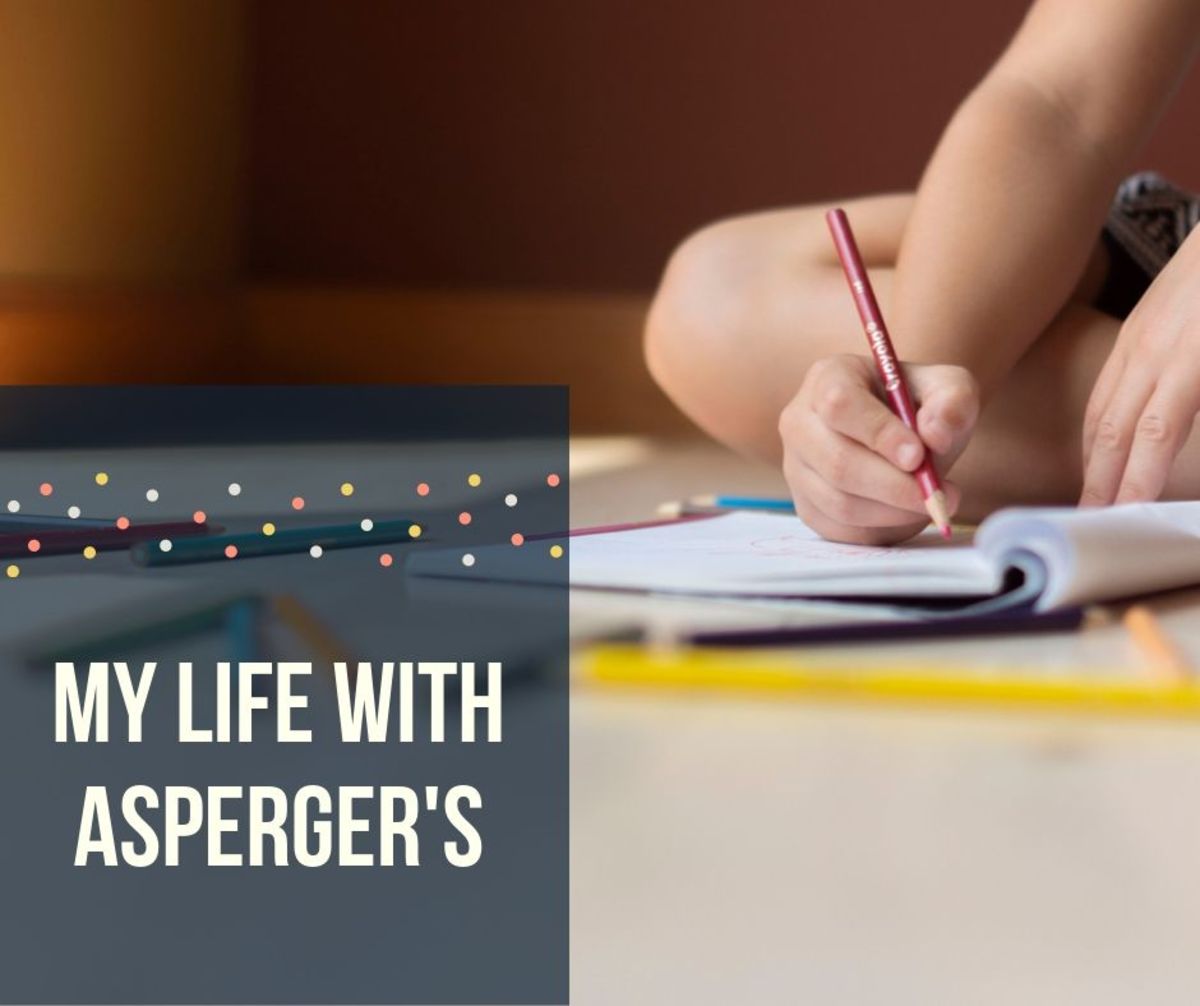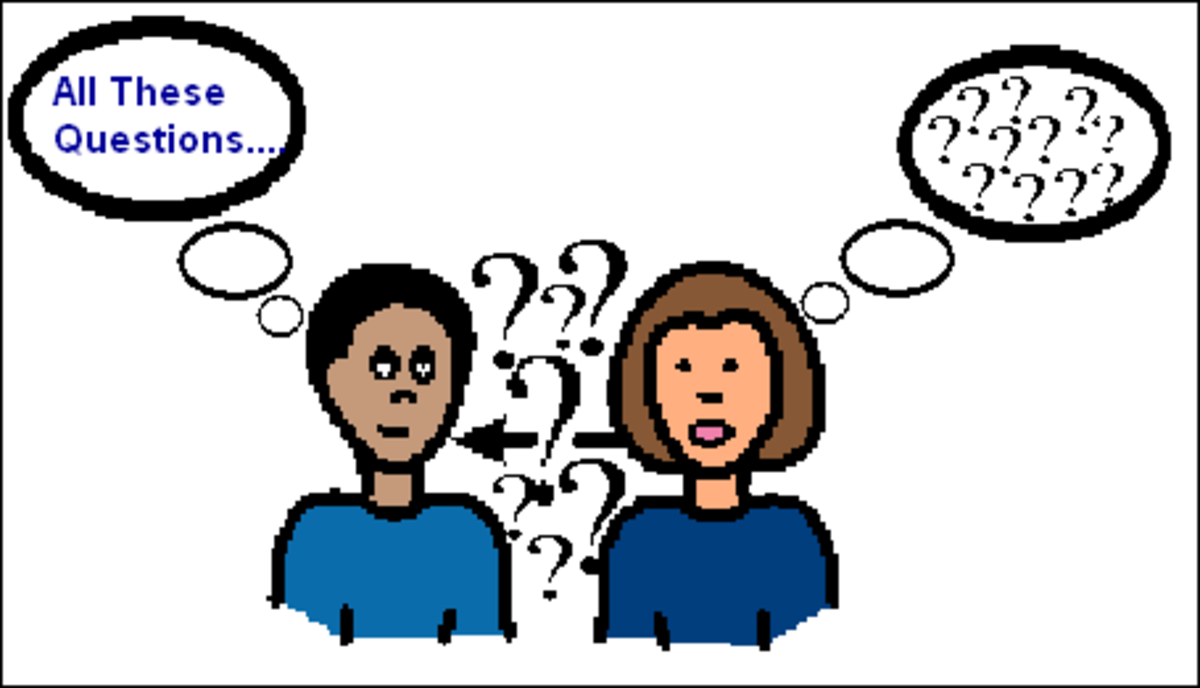- HubPages»
- Health»
- Diseases, Disorders & Conditions»
- Autism & Asperger's Syndrome
Autism: Understanding the Jargon
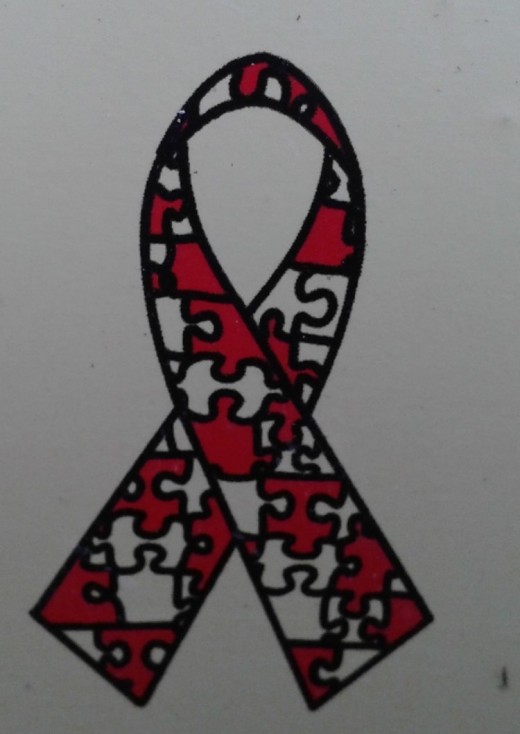
I often struggle with a way to define Autism and I do need to define it for people, because my daughter has Autism, and I want people to know what that means. Unfortunately, there is not one sentence that describes this disorder. I attempted to make one statement that describes Autism and it came out like this: “Autism is something that affects the brain in perhaps the areas of interacting with others, speaking, behaving, regulating emotions, having a high sensitivity to the five senses, school work problems, poor bath skills, and difficulties with physical health; but maybe only some of these areas.” That’s a mouthful and doesn’t totally describe all the problems an individual with Autism may have. I also have a card to hand people telling them my daughter has Autism. It does the best it can to describe many problems with Autism. There is not room to cover it all on the card, so I’ve decided to expand on the statements the card makes in this article. This card was made by TACA, and their website is http://www.tacanow.org. It says that “Autism is a Devastating Biological and Neurological Disorder, That Can Affect Individuals in Different Areas”. I’d like to point out the word “Biological” means that people with Autism did not “catch” the disorder and you cannot become Autistic if you’re not already Autistic after early childhood. “Neurological” means this affects the brain. People who have Autism have brains that work differently than what a “normal” person would. The card then gives a list of what the Areas affected are.
Do you know about Autism and/or do you know anyone with Autism?
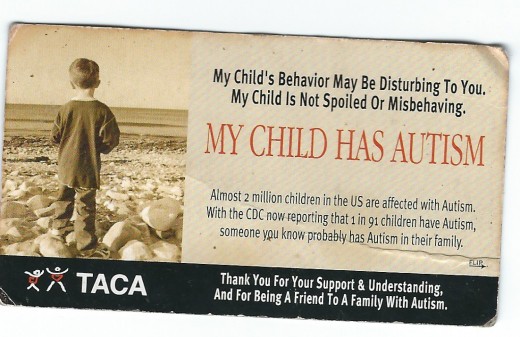
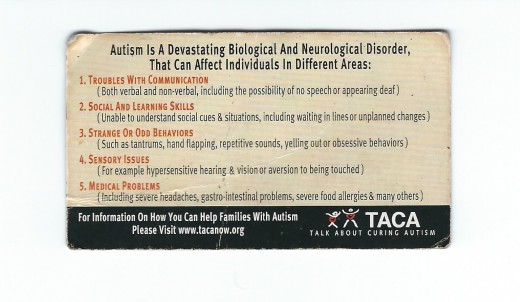
I will write in detail which each area of the card cover’s, but first of all I’d like to reiterate that people living with Autism learn differently, talk and express what they know differently (if at all), and sometimes behave differently. The words may, might, maybe, or sometimes, are used a lot because people living with Autism experience and express it in a huge range of ways. That’s why when people talk about Autism they often say “They’re on the Spectrum”. There is a spectrum of ways Autism can present in people. For simplicities sake we’ll say individuals with Autism can be on the severe, moderate, or mild ends of the spectrum. I do want to say that even though I use the words moderate and mild, that these diagnosis’ should not be brushed aside, because there are a lot of difficult problems people with these diagnosis’ may experience.
The first area that the card covers about Autism points out that people with Autism have troubles with communication. On the card there is word called “non-verbal” which means some people with Autism don’t talk. Some people on the spectrum also may appear deaf even though they’re not, they just don’t respond normally when someone tries to talk to them. This doesn’t mean all people living with Autism don’t speak or react to statements directed at them, some do. My daughter started talking normally, but then at the age of four she “regressed” or went backwards and could no longer talk at all. Not just making sounds, but not even pointing at things to indicate what she wanted. Slowly she started echoing everything a person said. Not to be annoying, but that’s how she processes information. This is called “echolalia”. Fortunately, working at Speech therapy she learned to talk basic English again. At first with the word “more” in sign language, and then she worked her way up to speaking a couple words, to sentences. Other than sign language she also used picture cards to label things like emotions, or things she wanted like candy. This is a system called “PECS”.
PECS book my daughter uses
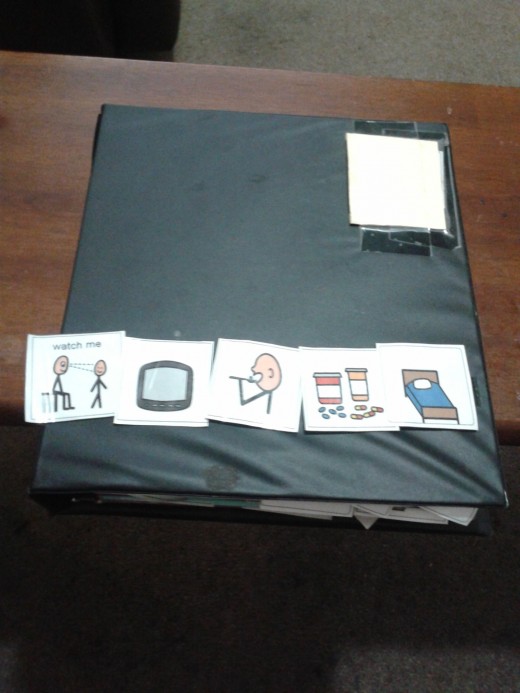
My daughter learned to talk with her voice which was a process that took at least ten years. She does have a problem not getting her words right sometimes though. She might say “yes” when she means “no”. Or she might label an animal wrong. This is a problem called “aphasia” and it is also part of her “expressive receptive disorder”. She cannot express what she means. While being “non-verbal” can be a definite indicator someone has Autism, it’s not a necessity for the disorder. Some people with Autism talk and listen quite well. The people who seem to talk and listen normally are usually on the moderate or mild end of the Autistic spectrum. Like I’ve mentioned before there is a “spectrum” of diagnosis of Autism. My daughter has been diagnosed on the severe end.
The second area the card covers says Autism affects Social and Learning Skills. The card says “Unable to understand social cues and situations, including waiting in line and unplanned changes.” Social cues basically means not knowing how to react when people behave a certain way. I mentioned the “expressive receptive” disorder before. Other than not being able to express herself, my daughter also takes a while to figure out what people say, or to process what’s going on around her. She “receives” information differently. There is a sign on our window that says “…May Not Respond to Verbal Command”. When a person tells someone with Autism what to do, they might not respond because they’re not able to process the information, or receive it, fast enough in their minds.
Sign in my window
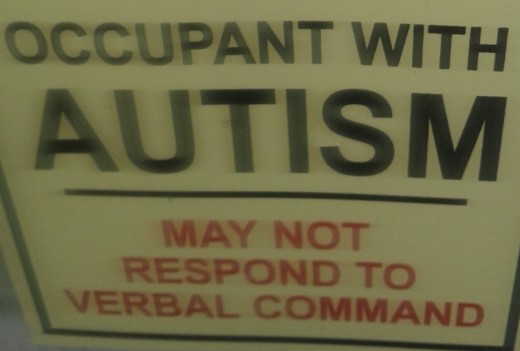
With social problems, it’s hard to figure out what happens in situations involving other people. For those on the spectrum, it’s hard to know how to treat others in the classroom or how to make friends, because they don’t know how to interact. It’s also hard for those with Autism to understand emotions of what other people are feeling. For example, they might not know how to try to comfort someone who is crying. They are not sure what crying means in other people. For those people who have Autism and know how to talk, they still might have a hard time approaching others asking them to play, (I’ve always had that problem myself). It is usually understood that people with Autism, on all ends of the spectrum, like routine and get upset if that routine is interrupted. I’d like to point out that while my daughter has some routines, she actually likes to be spontaneous sometimes, and might get depressed if she doesn’t get the opportunity to be that way. She always likes to know what to expect though. In order to help her do that, there are things called “social stories” which is usually a set of pictures detailing out exactly what will happen in a specific event like going to the dentist or doctor. It is also hard for many people on the spectrum to make eye-contact. Difficulty in making eye contact is a huge indicator of Autism, but like any symptom of Autism, some people can and do make eye contact. My daughter started out not doing it at all, but now she sometimes does.
The third area the card covers is “Strange or Odd Behaviors, such as tantrums, hand flapping, repetitive sounds, yelling or obsessive behaviors”. This strange behavior is somewhat covered in social problems. I’ve mentioned the repetitive sounds as echolalia. My daughter also mimics gestures and stances. She moves her hands around flapping them, and she also “bops” her head. This behavior can be called “stimming” in which an individual uses odd movements to calm themselves. Unfortunately, my daughter is fourteen years old and still has tantrums or “melt downs”. Having an Autistic child can look like having a spoiled child. These children are not spoiled though; their challenges just get the better of them. I wish more people knew that Autistic individuals had bad behavior and that normal parenting techniques don’t really work. It also causes a lot of problems, like daycare’s kicking them out because they can’t stop screaming (this has happened to my daughter). Then there is violence like hitting and hair pulling, resulting in negative school reports. She has often been violent to herself, banging her elbows on hard surfaces and in the past she banged her head on the floor without stopping. Once my daughter’s behavior was so bad she had to go to a children’s mental health hospital. People often say “let them bang their head, they’ll learn and stop”. Someone with Autism might not ‘learn’. There is another behavior problem having to do with going to the bathroom. It can be hard to toilet train someone with Autism. My daughter at age 14 still isn’t there yet. Some children on the spectrum also like to play with their poop. They put it on the walls and rub their hands in it. They smear it, thus it’s called “smearing”. I’m fortunate in that my daughter has no interest in that. There are other people on the spectrum whose behavior isn’t that bad which leaves some other parents of people on the Autistic spectrum still not understanding what a more severe person would look like. Often, understanding what Autism is and what it entails is very hard to find.
Emotion chart to explain behavior
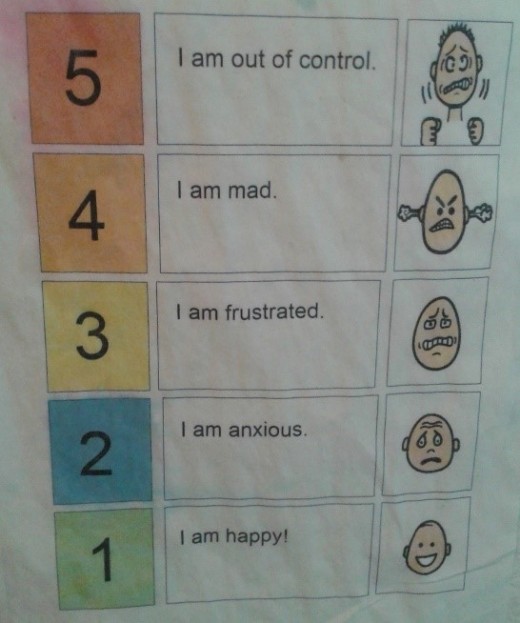
All the other areas that Autism affects might explain poor behavior. Beyond what we covered, the fourth area on the card says that Autistic people have “sensory issues”, which also may explain a defiant attitude. Autistic people have problems such as “hypersensitive hearing and vision or an aversion to being touched”. Sensory and hypersensitive means that someone can have super senses like hearing and touch, and it can mean they have trouble processing their senses. This can be called “Sensory Overload” and not being able to deal with the senses can also be called “Sensory Integration Disorder”. People without Autism can have this problem too. You might think that super hearing would be a benefit, but actually it’s a problem. My daughter hears ceiling fans in other rooms and it can throw her into a fit. Normal sounding voices can sound like screaming. I don’t know much about vision, but touch can be pleasant or unpleasant. Some people on the spectrum hate being touched because it can fill like being pinched. Other people, such as my daughter love cuddles and tickles. It all depends on the person and can affect someone with severe, moderate, or mild Autism. I’ve heard that people that are on the spectrum live in their own world. I don’t think this is true. They are perhaps experiencing the world more than ‘normal’ people do, thus the heightened senses. To help with sensory issues, my daughter takes physical therapy (which I refer to as PT), and at one point has taken occupational therapy (OT). Occupational therapy sounds like therapy to get a job, but it’s not, it’s therapy learning how to occupy your time. Kids learn how to get their hands messy with things like playdough and shaving cream. My daughter does the same things in PT. There are some tools to help with the senses that many people use to help with sensory issues and behavior. One is a “spio vest” which is a really tight vest that squeezes. It might sound painful, but many people with Autism like it. There are also “weighted blankets” which are blankets with weights in them. For the hearing sensitive there are also “noise cancelling head phones” which look like normal headphones, but the person wearing them can still hear, it just dials down the noise a little. My daughter has used these things a little bit through OT and PT. She takes PT, because she had problems catching and throwing a ball, and has a hard time doing things like touching toes where you have to bend the head down.
That leads us to the fifth and last area of the card which is medical problems. These can include “severe headaches, gastro-intestinal problems, food allergies” plus more. I don’t know about my daughter’s head hurting, but she always says her chest hurts. This might be a result of “acid reflux” where bile almost comes back up the chest and stays there without coming out or going back down. This could be a part of “gastro-intestinal’ problems which is also problems with diarrhea, constipation, and gas. Having to deal with these medical issues without being able to describe what’s wrong, might explain the poor behavior. Each area of Autism affects the others. My daughter also has allergies to gluten and casein. The easiest way to describe what gluten is, is to say “it’s wheat,” though it’s a little more than that which I’m not going to get into. It’s the same with a casein allergy which is an allergy to milk. Not lactose intolerance, but a true allergy to milk protein. These allergies affect my daughter’s digestion and might make her vomit. She also might get a rash. She takes medicine for these medical problems, but like many other people with Autism she also takes medicine for the Autism itself, helping her behave better. Many people are against this, but it has truly worked for her and I would have no peace without it. Medical issues are the last thing listed on the card, and this has been my detailed explanation for what is on the card.
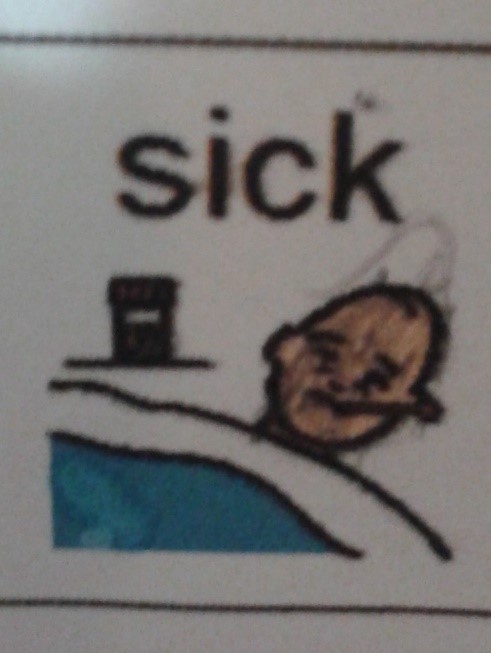
I also want to make mention of “savants”. People who are exceedingly good or a genius at one thing. In Rain Man, Raymond, who has Autism, knows how to do math really well so can count cards. He is a savant in math. When it’s heard that someone has Autism it might be assumed that the individual has a talent that they excel at. This is not necessarily true. Some people with Autism are savants and some are not. My daughter is really good at direction and she can remember many songs and sing them almost perfectly. Sometimes she doesn’t sing quite right though, so I wouldn’t call her a “savant”.
Now I want to go over the different words I defined:
- Biological- not contagious, affecting a person perhaps genetically
- Neurological- affecting the brain
- Spectrum- a wide array of things
- Non-Verbal- not being able to talk and perhaps not able to listen to commands
- Regressed- learning something, knowing it but then not being able to do it anymore
- Echolalia- a condition in which a person repeats most things they hear
- PECS- Picture Exchange Communication System. It is using pictures to communicate
- Aphasia- a problem where people might know what word they want to use, but are unable to express it, and/or they might say a word that doesn’t fit.
- Expressive Receptive Disorder- a disorder where people can’t express themselves and have a hard time processing what people say, and/or having a hard time processing situations
- Social Stories- stories often made of pictures detailing an event such as going to the dentist
- Stimming- odd hand flapping or gestures, perhaps used to calm self
- Smearing- flinging and playing with poop
- Sensory Issues- having trouble experiencing things related to the five senses, or feeling the senses too much. Also called “Sensory Overload” or “Sensory Integration Disorder”.
- Occupational Therapy- OT, a therapy in which a person learns how to occupy their time, often dealing with sensory issues
- Spio Vest- a tight vest that squeezes
- Weighted Blankets- heavy blankets, or blankets with weights in them
- Noise Cancelling Head Phones- not normal headphones, but looking like them, which can cancel out noise while still allowing to hear
- Acid Reflux- a problem where bile comes back up the throat but stays there without coming out.
- Gastro-Intestinal- has to do with digestion and can include problems with gas, heart burn, diarrhea and constipation
- Gluten- a wheat ingredient, many people are “gluten free”
- Casein- a milk protein
- Savant- someone being exceedingly good or a genius in one specific area
I’ve talked about the spectrum of Autism and symptoms it may entail. Now I’d like to cover what some of the diagnosis on the spectrum are, ranging from severe to mild. The definitions are in the table below.
Types of Autism
Severe
| Autistic Disorder
| Experiencing all or most areas of Autism in an intense way.
|
|---|---|---|
Severe
| Childhood Disintegrative Disorder (CDD)
| Progressing normally and then going backwards and not progressing normally anymore. My daughter has this.
|
Moderate
| Pervasive Developmental Disorder Not Otherwise Specified (PDD-NOS) or Atypical Autism
| May experience all symptoms of Autism, but not all areas are so severe.
|
Mild
| High Functioning Autism or Asperger’s
| Usually someone who can talk, but finds it hard to process. Sometimes involves awkward situations and almost obsessive behaviors, plus more.
|
Lastly I have made a video of my daughter in order to raise money for a new car, which we need in order to make it to therapies. Notice how she “echoes” things I say, and doesn’t really start any conversation or story. She makes good eye contact with the camera, but it took her awhile to learn that. Notice how when I ask her to sing, she only sings one line even though she can sing the entire song really well. We need to continue to take her to her therapies and that’s why I’m asking for this.

